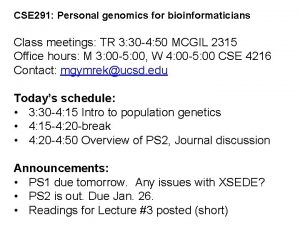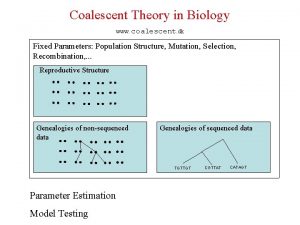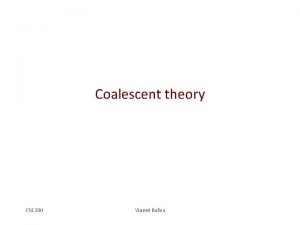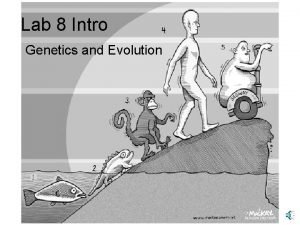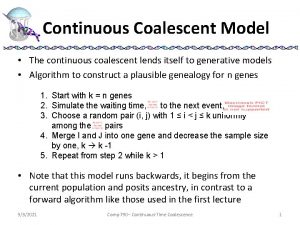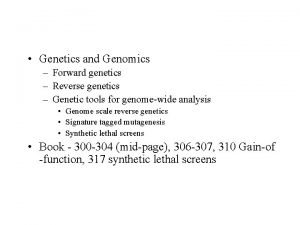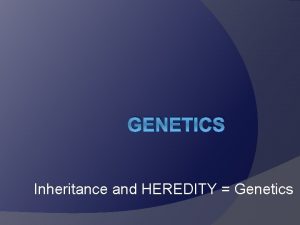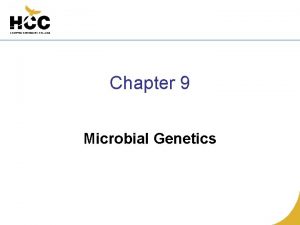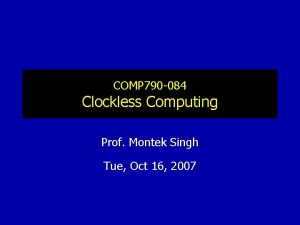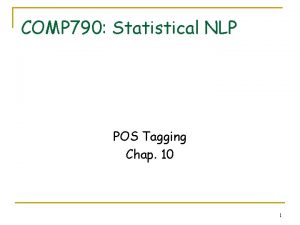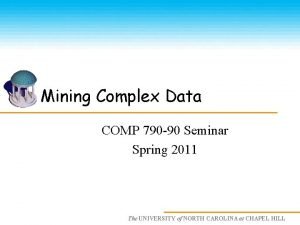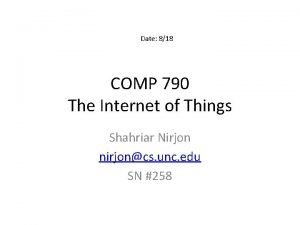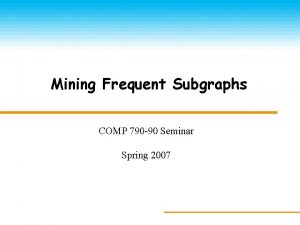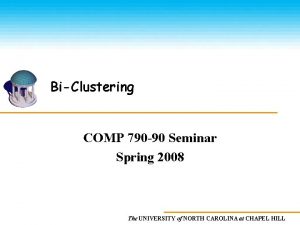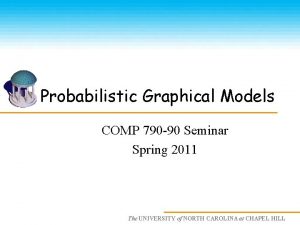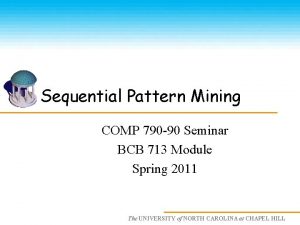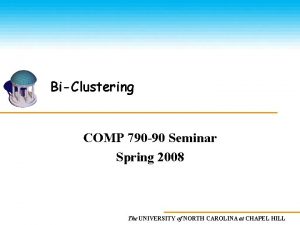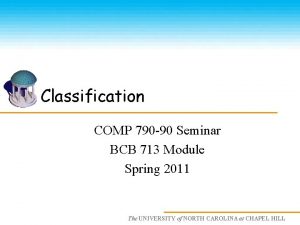Comp 790 087 Genetics Evolution and the Coalescent
















![Same Result Females ['AA', 'BB', 'CC', 'DD', 'EE', 'FF', 'GG', 'HH', 'II', 'JJ'] ['AG', Same Result Females ['AA', 'BB', 'CC', 'DD', 'EE', 'FF', 'GG', 'HH', 'II', 'JJ'] ['AG',](https://slidetodoc.com/presentation_image_h/0b6655deb6fff4e07f565e21091b4d51/image-17.jpg)





- Slides: 22

Comp 790 -087 Genetics, Evolution, and the Coalescent Theory • Administrative Details • Course Overview • Coalescent Theory? 2/23/2021 Comp 790– Introduction & Coalescence 1

Course Overview • Synopsis – Graduate-level project course – Guided reading, discussions, and project with write-up • Website – To appear at: http: //www. unc. edu/courses/2009 spring/comp/790/087/ • Course Grading – Class Participation 10% – 2 In-class Presentations 40% – Final Project, Presentation, & Write-up 50% 2/23/2021 Comp 790– Introduction & Coalescence 2

Syllabus • ⅓ Guided reading/discussion of text • ⅓ Student presentations of recent papers • ⅓ Project Proposals 2/23/2021 Comp 790– Introduction & Coalescence 3

Coalescent Theory • Ancestral properties can be inferred from extant populations • Alternatives to Correctness – Most-Likely – Most Parsimonious – Other optimality criteria • Background – Biology (genetics) – Statistics – Computational Modeling 2/23/2021 Comp 790– Introduction & Coalescence 4

Non-Classical Genetics • Coalescence differs from classical genetics – Analysis rather than synthesis – Depends on models, which attempt to explain observations – Less emphasis on Darwin’s natural selection • Considers population dynamics – Isolation – Bottlenecks 2/23/2021 Comp 790– Introduction & Coalescence 5

Historical Human Migrations 2/23/2021 Comp 790– Introduction & Coalescence 6

Population Dynamics • It is helpful to view evolutionary trees in the contexts of geography and population structure • These factors affect the prevalence and distribution of genes • Genetic diversity largely depends on population isolation and population bottlenecks, as well as – Constant population size (resource limited) – Sudden increases in population (explosions) – Patterns of growth (exponential, uniform, etc. ) 2/23/2021 Comp 665 – Introduction & Signals 7

It’s About Genes • Genetics is most clearly understood by considering its subject to be genes rather than organisms • Organisms are merely vessels for assuring the survival of genes • Successful genes live on long after their host organism • An objective of a gene is to replicate itself “[Genes] that survived were the ones that built survival machines for themselves to live in. But making a living got steadily harder as new rivals arose with better and more effective survivial machines. Survival machines got bigger and more eloborate, and the process was cumulative and progressive…” -- Dawkins, The Selfish Gene 2/23/2021 Comp 790– Introduction & Coalescence 8

Why Computer Science • Classically, genetics, both generative (classical) and coalescent (population) has focused on mathematical/statistical models • As model complexity increases, it becomes harder to find closed-form solutions • Relies more and more on computational modeling to ascertain structure • Also, complicated models often lead to common models… today’s subject 2/23/2021 Comp 790– Introduction & Coalescence 9

Wright-Fisher Model • One of the first, and simplest models of population genealogies was introduced by Wright (1931) and Fisher (1930). • Model emphasizes transmission of genes from one generation to the next • For simplicity we’ll first focus on a fixed population size, each with a distinct gene variant 2/23/2021 Comp 790– Introduction & Coalescence 10

Simple Haploid Model • Rules G 0: ['A', 'B', 'C', 'D', 'E', 'F', 'G', 'H', 'I', 'J'] – Antecedent genes are chosen randomly, with replacement, from their parental generation – No selection – Fixed population size 2/23/2021 G 1: ['J', 'A', 'H', 'B', 'I', 'E', 'D', 'G', 'A', 'B'] G 2: ['A', 'J', 'E', 'G', 'D', 'E', 'B', 'I', 'A'] G 3: ['A', 'E', 'J', 'I', 'A', 'J', 'B'] G 4: ['E', 'A', 'B', 'A', 'E', 'A', 'A'] G 5: ['A', 'B', 'A', 'E', 'A', 'B'] G 6: ['A', 'A', 'B', 'A'] G 7: ['B', 'A', 'A', 'A'] What will this population eventually look like? Comp 790– Introduction & Coalescence 11

Assumptions of Wright/Fisher • • • Discrete and non-overlapping generations Haploid individuals Populations size is constant All individuals are equally fit No population of social structure Genes segregate independently 2/23/2021 Comp 790– Introduction & Coalescence 12

Some Graphical Abstractions • Replace letters with colors • Draw lineages • Sort topologically 2/23/2021 Comp 790– Introduction & Coalescence 13

Repeats Every population results in just one gene 2/23/2021 Comp 790– Introduction & Coalescence 14

Onset of Uniformity • 10000 trials • Mode = 11 (616) • Mean = 17. 5 2/23/2021 Comp 790– Introduction & Coalescence 15

Diploid Model • Our model is obviously too simple, let’s add more realism • Organisms are diploid (have 2, perhaps different, copies of each gene) • Sexual reproduction • Half female, Half Male 2/23/2021 Females Males ['AA', 'BB', 'CC', 'DD', 'EE', 'FF', 'GG', 'HH', 'II', 'JJ'] ['CF', 'AG', 'BI', 'CH', 'EG', 'EH', 'EI', 'DG'] ['CE', 'IE', 'CG', 'HE', 'FG', 'IG', 'BE', 'BG', 'HE'] ['CB', 'EI', 'HE', 'HI', 'HE', 'CG', 'EF', 'EI', 'HF', 'GI'] ['EE', 'HF', 'BC', 'IG', 'BH', 'HI', 'BI', 'EF', 'HG', 'HC'] ['CH', 'BH', 'EI', 'BH', 'BE', 'BI', 'HC', 'EH', 'IH'] ['BE', 'IB', 'BE', 'BH', 'HH', 'CB', 'EH'] ['BH', 'EC', 'BB', 'IC', 'BH', 'EH', 'BE', 'EB'] ['CE', 'BE', 'CH', 'BE', 'CB', 'HE', 'IB', 'CB'] ['EH', 'BB', 'BH', 'EC', 'EE', 'EC', 'CE', 'CI', 'CE'] ['CI', 'BE', 'EC', 'BE', 'BC', 'BE', 'BC'] ['EB', 'BB', 'CB', 'EB', 'CC', 'IB', 'BC', 'IE', 'CB'] ['BB', 'EC', 'BE', 'BC', 'CC', 'EI', 'BC', 'BC'] ['EB', 'CC', 'BB', 'CC', 'BI', 'CC', 'BC', 'CC'] ['BC', 'CC', 'BC', 'EC', 'BB', 'BC', 'BB'] ['BB', 'BC', 'CB', 'CC', 'CB', 'CE', 'CB'] ['CC', 'CB', 'BB', 'CC', 'BC'] ['CC', 'BB', 'CC', 'BC', 'CC', 'CB'] ['CC', 'BC', 'CC', 'CB', 'CC'] ['CC', 'BC', 'CC', 'CC', 'BC', 'CC'] ['CC', 'CC', 'BC', 'CB'] ['CC', 'BC', 'CC', 'CC', 'CC'] ['CC', 'CC', 'BC', 'CC', 'CC'] ['CC', 'CC', 'CC', 'CC'] Comp 790– Introduction & Coalescence 16
![Same Result Females AA BB CC DD EE FF GG HH II JJ AG Same Result Females ['AA', 'BB', 'CC', 'DD', 'EE', 'FF', 'GG', 'HH', 'II', 'JJ'] ['AG',](https://slidetodoc.com/presentation_image_h/0b6655deb6fff4e07f565e21091b4d51/image-17.jpg)
Same Result Females ['AA', 'BB', 'CC', 'DD', 'EE', 'FF', 'GG', 'HH', 'II', 'JJ'] ['AG', 'BF', 'AI', 'EJ', 'DH', 'AH', 'CH', 'AI', 'DI', 'AH'] ['BI', 'AI', 'FA', 'AC', 'GH', 'AH', 'BI', 'DH', 'FI', 'AH'] ['HH', 'AI', 'BH', 'II', 'AI', 'GI', 'AD', 'IA', 'AA'] ['HG', 'ID', 'IA', 'ID', 'HG', 'HI', 'AA', 'AI', 'IA'] ['IA', 'DG', 'DH', 'HA', 'GA', 'DI', 'GH', 'GG', 'II', 'IH'] ['HI', 'GH', 'DH', 'GG', 'HH', 'II', 'HI', 'ID', 'GH'] ['HH', 'GI', 'HI', 'HH', 'IH', 'HI', 'GG', 'HH'] ['GH', 'HH', 'II', 'HH', 'HI', 'HG', 'HH'] ['HI', 'HG', 'HH', 'IH', 'HH', 'GH', 'HI', 'HH'] ['HH', 'HI', 'HG', 'HH', 'IH'] ['HH', 'HH', 'IH', 'GH', 'HH', 'GH'] ['HI', 'HH', 'HG', 'HH', 'HI', 'HG', 'HH'] ['GG', 'GH', 'HI', 'HH', 'IG', 'GH', 'IG', 'HH', 'HH'] ['IH', 'HG', 'HI', 'GH', 'HH', 'GI', 'IG', 'HH', 'GH'] ['IH', 'HG', 'II', 'HH', 'HG', 'IH'] ['II', 'HI', 'HH', 'IH', 'HH', 'GI', 'HH'] ['IH', 'II', 'HH', 'IH', 'HH'] ['HH', 'II', 'IH', 'HH', 'IH'] ['IH', 'HH', 'II', 'IH'] ['HI', 'IH', 'HI', 'IH', 'HI', 'HH'] ['IH', 'HI', 'HH', 'II', 'IH', 'HH'] ['II', 'HH', 'HH', 'HI', 'HH', 'II'] ['IH', 'HI', 'HH', 'HH', 'IH', 'HI'] ['IH', 'HI', 'IH', 'HH', 'HI', 'HH'] ['HI', 'HH', 'HH', 'HI', 'HH'] ['HH', 'IH', 'HI', 'HH', 'HH'] ['HH', 'IH', 'HH', 'HH'] ['HH', 'HH', 'HH', 'HH'] 2/23/2021 Males Females ['AA', 'BB', 'CC', 'DD', 'EE', 'FF', 'GG', 'HH', 'II', 'JJ'] ['EF', 'EI', 'DI', 'BF', 'EJ', 'BI', 'AI', 'CI', 'EJ', 'EI'] ['FB', 'EE', 'EI', 'JB', 'FE', 'BJ', 'JE', 'EI', 'EE', 'DI'] ['FJ', 'IE', 'FE', 'JE', 'EJ', 'FI', 'FE', 'BJ', 'EB', 'FJ'] ['FF', 'II', 'EB', 'FI', 'EJ', 'EB', 'IB', 'EI', 'EF'] ['FE', 'IE', 'BB', 'BE', 'EB', 'IE', 'BI', 'FJ'] ['BB', 'FE', 'EE', 'BJ', 'II', 'EE', 'BE', 'FE'] ['BB', 'EB', 'EE', 'EI', 'EE', 'FI', 'EE', 'EE'] ['EF', 'BE', 'EE', 'BE', 'IE', 'BI', 'EE', 'EE'] ['EE', 'BE', 'FE', 'EB', 'EE', 'BE', 'FE', 'EE'] ['EF', 'EE', 'EE', 'FE', 'EB', 'BE', 'EE'] ['EE', 'FB', 'EE', 'EE', 'EE'] ['EE', 'EE', 'BE', 'EE'] ['EE', 'EE', 'EE', 'EE'] Females Males ['AA', 'BB', 'CC', 'DD', 'EE', 'FF', 'GG', 'HH', 'II', 'JJ'] ['AF', 'AJ', 'AF', 'CG', 'BH', 'AH', 'EG', 'DJ'] ['AA', 'AH', 'CA', 'AJ', 'BJ', 'GB', 'AB', 'GH', 'BB', 'AA'] ['JH', 'AB', 'AA', 'AG', 'AB', 'JB', 'AH', 'AA', 'AG'] ['GA', 'AG', 'BH', 'AB', 'BA', 'GA', 'AA', 'AA'] ['AA', 'AG', 'AA', 'AB', 'AA'] ['AA', 'AB', 'AA', 'AA', 'AA'] ['BA', 'AA', 'BA', 'AA', 'AA'] ['AB', 'AA', 'AA', 'AA'] ['AA', 'BA', 'AA', 'AA', 'AA'] ['AA', 'BA', 'AA', 'AA'] ['AA', 'AA', 'BA', 'AA'] ['AA', 'AA', 'AB', 'AA'] ['AA', 'AA', 'AA', 'AA'] Comp 790– Introduction & Coalescence 17

Similar Distributions • 10000 trials • Mode = 24 (291) • Mean = 35. 5 • These statistics are almost exactly 2 x the haploid (Mode = 11, Mean = 17. 5) 2/23/2021 Comp 790– Introduction & Coalescence 18

Punnett Squares AA x BB A A AB x AB A B B AB AB A AA AB BB AB x BB A B B AB BB What if we introduce inbreeding, by choosing mates from common litters, in successive generations 2/23/2021 Comp 790– Introduction & Coalescence 19


Distributions 2/23/2021 Comp 790– Introduction & Coalescence 21

Next time • Commonly occurring distributions – Geometric – Exponential 2/23/2021 Comp 790– Introduction & Coalescence 22
 Cine depune declaratia 087
Cine depune declaratia 087 Coalescent theory
Coalescent theory Coalescent theory
Coalescent theory Coalescent theory
Coalescent theory Remus ktm 790 adventure
Remus ktm 790 adventure Bearing and meridian
Bearing and meridian Tae no.790
Tae no.790 Directive 2019/790
Directive 2019/790 Similar
Similar Hình ảnh bộ gõ cơ thể búng tay
Hình ảnh bộ gõ cơ thể búng tay Slidetodoc
Slidetodoc Bổ thể
Bổ thể Tỉ lệ cơ thể trẻ em
Tỉ lệ cơ thể trẻ em Gấu đi như thế nào
Gấu đi như thế nào Glasgow thang điểm
Glasgow thang điểm Hát lên người ơi
Hát lên người ơi Các môn thể thao bắt đầu bằng tiếng đua
Các môn thể thao bắt đầu bằng tiếng đua Thế nào là hệ số cao nhất
Thế nào là hệ số cao nhất Các châu lục và đại dương trên thế giới
Các châu lục và đại dương trên thế giới Công của trọng lực
Công của trọng lực Trời xanh đây là của chúng ta thể thơ
Trời xanh đây là của chúng ta thể thơ Cách giải mật thư tọa độ
Cách giải mật thư tọa độ Làm thế nào để 102-1=99
Làm thế nào để 102-1=99

